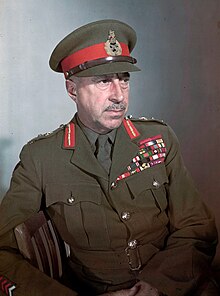General Henry Duncan Graham Crerar CH, CB, , DSO, CD, PC (28 April 1888 – 1 April 1965) was a senior officer of the Canadian Army who became the country's senior field commander in the Second World War as commander of the First Canadian Army in the campaign in North West Europe in 1944–1945, having rapidly risen in rank from brigadier in 1939 to that of a full general in 1944.
A graduate of the Royal Military College of Canada, in Kingston, Ontario, Crerar was commissioned as a lieutenant in the Non-Permanent Active Militia in 1909, serving with the 4th Battery, Canadian Field Artillery, which was based in Hamilton, Ontario. He rose to the rank of lieutenant-colonel in the artillery in the First World War, during which he was mentioned in despatches and made a member of the Distinguished Service Order (DSO). Electing to remain in the army as a professional soldier after the war, he attended the Staff College, Camberley, from 1923 to 1924, and the Imperial Defence College in 1934. He was appointed Director of Military Operations & Military Intelligence in 1935 and Commandant of the Royal Military College of Canada in 1939.
During the Second World War he became General Officer Commanding the 2nd Canadian Infantry Division, which was then stationed in England, in late 1941. He was promoted to lieutenant-general and assumed command of I Canadian Corps, fighting briefly in the Italian campaign in late 1943 and in early 1944. In March 1944 he returned to the United Kingdom where he assumed command of the First Canadian Army which, although designated the Canadian First Army, contained a significant amount of British and Polish troops, including the British I Corps and the Polish 1st Armoured Division. Under Crerar's command, the First Canadian Army fought in the latter stages of the Battle of Normandy in July−August 1944, participating in Operation Totalize, Operation Tractable and the Battle of the Falaise Pocket, before being tasked with clearing the Channel Coast. Crerar was promoted to full general on 16 November 1944, becoming the first Canadian officer to hold that rank in the field. During Operation Veritable, the battle for the Rhineland in 1945, the First Canadian Army controlled nine British divisions. The Army became more Canadian with Operation Goldflake, the redeployment of the I Canadian Corps from Italy, and played a key role in the liberation of the western Netherlands in April 1945, shortly before the end of World War II in Europe.
With the war over, Crerar retired from military service in 1946 and, despite his many achievements, soon faded into relative obscurity until his death in 1965. J. L. Granatstein wrote of Crerar that: "No other single officer had such impact on the raising, fighting, and eventual disbanding of the greatest army Canada has ever known. Crerar was unquestionably the most important Canadian soldier of the war."[1]
- ^ Granatstein 1993, p. 83.
